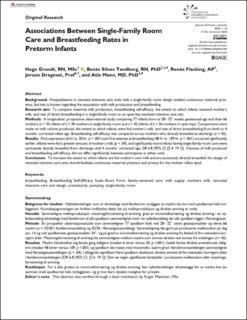Associations between single-family room care and breastfeeding rates in preterm infants
Journal article, Peer reviewed
Published version

Åpne
Permanent lenke
https://hdl.handle.net/11250/2739949Utgivelsesdato
2020Metadata
Vis full innførselSamlinger
- Department of Clinical Science [2318]
- Registrations from Cristin [9791]
Sammendrag
Background
Hospitalization in neonatal intensive care units with a single-family room design enables continuous maternal presence, but less is known regarding the association with milk production and breastfeeding.
Research aim
To compare maternal milk production, breastfeeding self-efficacy, the extent to which infants received mother’s milk, and rate of direct breastfeeding in a single-family room to an open bay neonatal intensive care unit.
Methods
A longitudinal, prospective observational study comparing 77 infants born at 28– 32° weeks gestational age and their 66 mothers (n = 35 infants of n = 30 mothers in single family room and n = 42 infants of n = 36 mothers in open bay). Comparisons were made on milk volume produced, the extent to which infants were fed mother’s milk, and rate of direct breastfeeding from birth to 4 months’ corrected infant age. Breastfeeding self-efficacy was compared across mothers who directly breastfed at discharge (n = 45).
Results
First expression (6 hr vs. 30 hr, p < .001) and first attempt at breastfeeding (48 hr vs. 109 hr, p < .001) occurred significantly earlier, infants were fed a greater amount of mother’s milk (p < .04), and significantly more infants having single-family room care were exclusively directly breastfed from discharge until 4 months’ corrected age; OR 6.8 (95% CI [2.4, 19.1]). Volumes of milk produced and breastfeeding self-efficacy did not differ significantly between participants in either units.
Conclusion
To increase the extent to which infants are fed mother’s own milk and are exclusively directly breastfed, the design of neonatal intensive care units should facilitate continuous maternal presence and privacy for the mother–infant dyad.
